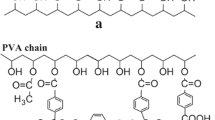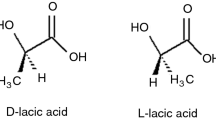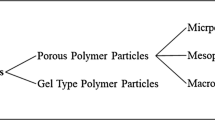Abstract
In this study, the free radical copolymerization of glycidyl methacrylate (GMA) and methyl methacrylate (MMA) was investigated for the first time by solution free radical copolymerization in toluene at 80 °C using azobisisobutyronitrile as an initiator. The 1H-NMR spectroscopy has been used for determining the copolymer composition. Monomer reactivity ratios (r values) were calculated by various linear least-square methods. According to the results, using the Kelen–Tüdös (KT) and extended Kelen–Tüdös (Ex KT) methods the r values were obtained as \( r_{\text{G}} = 1.528 \pm 0.168 \), \( r_{\text{M}} = 0.789 \pm 0.121 \), and \( r_{\text{G}} = 1.577 \pm 0.186 \), \( r_{\text{M}} = 0.783 \pm 0.129 \), respectively. The calculated monomer reactivity ratios showed the higher reactivity for GMA (rG) compared to MMA (rM). Furthermore, the findings demonstrated random or ideal behavior (\( r_{\text{G}} \cdot r_{\text{M}} \simeq 1 \)) for these copolymers. The monomers sequence distribution as probability of finding the multiple sequence distribution of the GMA and MMA units in copolymers was calculated and showed higher probabilities for GMA sequences. Thermogravimetric analysis of the copolymers had three degradation stages, and the main degradation occurred at third stage (340–456 °C) with 56% weight loss. Also, with regard to initial temperature of degradation and T50, the thermal stability was improved 62% and 2.3%, respectively, by increasing MMA content in copolymer. These studies could uncover the underlying GMA–MMA composition in copolymer, shedding light on the future design of top-performing applications such as UV printing ink and resin industry.
Graphic abstract









Similar content being viewed by others
References
Abdollahi H, Najafi V, Ziaee F et al (2014) Radical copolymerization of acrylic acid and OEGMA475: monomer reactivity ratios and structural parameters of the copolymer. Macromol Res 22:1330–1336. https://doi.org/10.1007/s13233-014-2190-y
Amiri F, Kabiri K, Bouhendi H et al (2018) High gel-strength hybrid hydrogels based on modified starch through surface cross-linking technique. Polym Bull. https://doi.org/10.1007/s00289-018-2593-6
Odian G (2004) Principles of polymerization, 4th edn. Academic Press, New York
Ko KY, Baek SS, Hwang SH (2018) Synthesis of imide-based methacrylic monomers and their copolymerization with methyl methacrylate: monomer reactivity ratios and heat resistance properties. Polym Int 67:957–963. https://doi.org/10.1002/pi.5594
Gabriel VA, Dubé MA (2018) Bulk free-radical co- and terpolymerization of n-butyl acrylate/2-ethylhexyl acrylate/methyl methacrylate. Macromol React Eng 1800057:1–8. https://doi.org/10.1002/mren.201800057
Mao R, Huglin MB (1994) A new linear method to calculate monomer reactivity ratios by using high-conversion copolymerization data: penultimate model with r2 = 0. Polymer (Guildf) 35:3525–3529. https://doi.org/10.1016/0032-3861(94)90918-0
Darvishi A, Zohuriaan Mehr MJ, Marandi GB et al (2013) Copolymers of glycidyl methacrylate and octadecyl acrylate: synthesis, characterization, swelling properties, and reactivity ratios. Des Monomers Polym 16:79–88. https://doi.org/10.1080/15685551.2012.705493
Najafi V, Ziaee F, Kabiri K et al (2012) Aqueous free-radical polymerization of PEGMEMA macromer: kinetic studies via an on-line 1H NMR technique. Iran Polym J (English Ed) 21:683–688. https://doi.org/10.1007/s13726-012-0072-8
Jalilian SM, Farhadnejad H, Ziaee F et al (2016) Poly(n-octyl methacrylate) viscosity index improver: kinetic study via on-line 1H-NMR technique. Polym Sci Ser B 58:675–680. https://doi.org/10.1134/S1560090416060087
Debnath D, Baughman JA, Datta S et al (2018) Determination of the radical reactivity ratios of 2-(N-ethylperfluorooctanesulfonamido)ethyl acrylate and methacrylate in copolymerizations with N,N-dimethylacrylamide by in situ 1H NMR analysis as established for styrene-methyl methacrylate copolymerization. Macromolecules 51:7951–7963. https://doi.org/10.1021/acs.macromol.8b01526
Feng J, Oyeneye O, Xu WZ, Charpentier P (2018) In-situ NMR measurement of reactivity ratios for copolymerization of methyl methacrylate and diallyl dimethylammonium chloride. Ind Eng Chem Res 57:15654–15662. https://doi.org/10.1021/acs.iecr.8b04033
Barsbay M, Güven O, Kodama Y (2016) Amine functionalization of cellulose surface grafted with glycidyl methacrylate by γ-initiated RAFT polymerization. Radiat Phys Chem 124:140–144. https://doi.org/10.1016/j.radphyschem.2015.12.015
Muzammil EM, Khan A, Stuparu MC (2017) Post-polymerization modification reactions of poly(glycidyl methacrylate)s. RSC Adv 7:55874–55884. https://doi.org/10.1039/c7ra11093f
Hong S, Kim J, Kim MS, Kim BW (2012) Radical polymerization of acrylate copolymer-based GMA for use as a UV-curable layer via thin coating. Adv Polym Technol 31:271–279. https://doi.org/10.1002/adv.20250
Paul S, Ranby B (1976) Studies of methyl methacrylate-glycidyl methacrylate copolymers: copolymerization to low molecular weights and modification by ring-opening reaction of epoxy side groups. J Polym Sci 14:2449–2461. https://doi.org/10.1002/pol.1976.170141012
Ziaee F, Nekoomanesh M (1998) Monomer reactivity ratios of styrene-butyl acrylate copolymers at low and high conversions. Polymer 39:203–207. https://doi.org/10.1016/S0032-3861(97)00249-8
Bradbury JH, Melville HW (1954) The co-polymerization of styrene and butyl acrylate in benzene solution. Proc R Soc Lond Ser A Math Phys Sci 222:456–470. https://doi.org/10.1098/rspa.1954.0088
Neugebauer D, Bury K, Wlazło M (2012) Atom transfer radical copolymerization of glycidyl methacrylate and methyl methacrylate. J Appl Polym Sci 124:2209–2215. https://doi.org/10.1002/app.35234
Abdollahi H, Salimi A, Barikani M et al (2019) Systematic investigation of mechanical properties and fracture toughness of epoxy networks: role of the polyetheramine structural parameters. J Appl Polym Sci. https://doi.org/10.1002/app.47121
Erbil C, Özdemir S, Uyanik N (2000) Determination of the monomer reactivity ratios for copolymerization of itaconic acid and acrylamide by conductometric titration method. Polymer 41:1391–1394. https://doi.org/10.1016/S0032-3861(99)00291-8
Uyanik N, Erbil C (2000) Monomer reactivity ratios of itaconic acid and acrylamide copolymers determined by using potentiometric titration method. Eur Polym J 36:2651–2654. https://doi.org/10.1016/S0014-3057(00)00045-8
Thirumoolan D, Anver Basha K, Kanai T et al (2016) Synthesis, characterization and reactivity ratios of poly N-(p-bromophenyl)-2-methacrylamide-Co-N-vinyl-2-pyrrolidone. J Saudi Chem Soc 20:195–200. https://doi.org/10.1016/j.jscs.2013.09.003
Hasanzadeh R, Moghadam PN, Bahri-Laleh N, Ziaee F (2016) A reactive copolymer based on glycidylmethacrylate and maleic anhydride: 1-synthesis, characterization and monomer reactivity ratios. J Polym Res. https://doi.org/10.1007/s10965-016-1048-8
Bakhshi H, Zohuriaan-Mehr MJ, Bouhendi H, Kabiri K (2009) Spectral and chemical determination of copolymer composition of poly(butyl acrylate-co-glycidyl methacrylate) from emulsion polymerization. Polym Test 28:730–736. https://doi.org/10.1016/j.polymertesting.2009.06.003
Chanda M (2006) Introduction to polymer science and chemistry. CRC Press, Boca Raton
Erol I, Devrim DN, Ciftci H et al (2017) Novel functional copolymers based on glycidyl methacrylate: synthesis, characterization, and polymerization kinetics. J Macromol Sci Part A Pure Appl Chem 54:434–445. https://doi.org/10.1080/10601325.2017.1320747
Bauduin G, Boutevin B, Belbachir M, Meghabar R (1995) Determination of reactivity ratios in radical copolymerization: a comparison of methods for a methacrylate/N-vinylpyrrolidone system. Macromolecules 28:1750–1753. https://doi.org/10.1021/ma00110a004
Braun D, Brendlein W, Mott G (1973) A simple method of determining copolymerization reactivity ratios by means of a computer. Eur Polym J 9:1007–1012. https://doi.org/10.1016/0014-3057(73)90077-3
Jenkins AD, Hatada K, Kitayama T, Nishiura T (2000) Revised patterns of reactivity scheme. VII. Revised patterns scheme and its relationship to carbon-13 NMR spectra. J Polym Sci Part A Polym Chem 38:4336–4342. https://doi.org/10.1002/1099-0518(20001215)
Manring LE (1991) Thermal degradation of poly(methyl methacrylate): random side-group scission. Macromolecules 24:3304–3309. https://doi.org/10.1021/ma00011a040
Zulfiqar S, Zulfiqar M, Nawaz M et al (1990) Thermal degradation of poly(glycidyl methacrylate). Polym Degrad Stab 30(2):195–203
Author information
Authors and Affiliations
Corresponding author
Additional information
Publisher's Note
Springer Nature remains neutral with regard to jurisdictional claims in published maps and institutional affiliations.
Rights and permissions
About this article
Cite this article
Abdollahi, H., Najafi, V. & Amiri, F. Determination of monomer reactivity ratios and thermal properties of poly(GMA-co-MMA) copolymers. Polym. Bull. 78, 493–511 (2021). https://doi.org/10.1007/s00289-020-03123-5
Received:
Revised:
Accepted:
Published:
Issue Date:
DOI: https://doi.org/10.1007/s00289-020-03123-5




